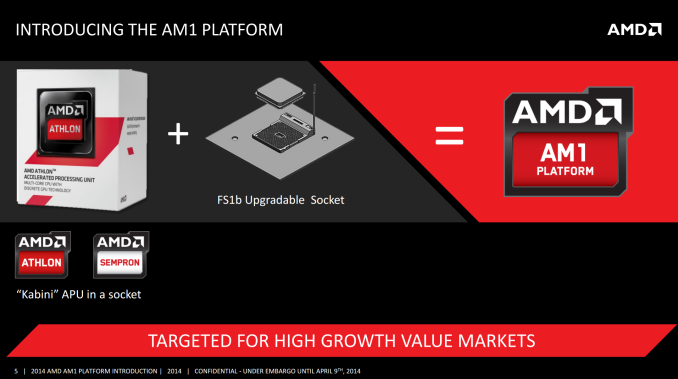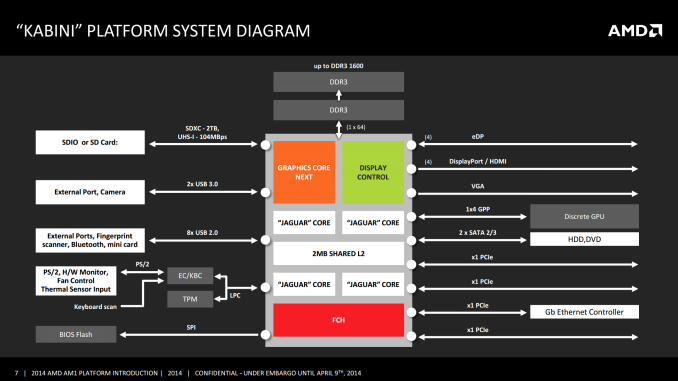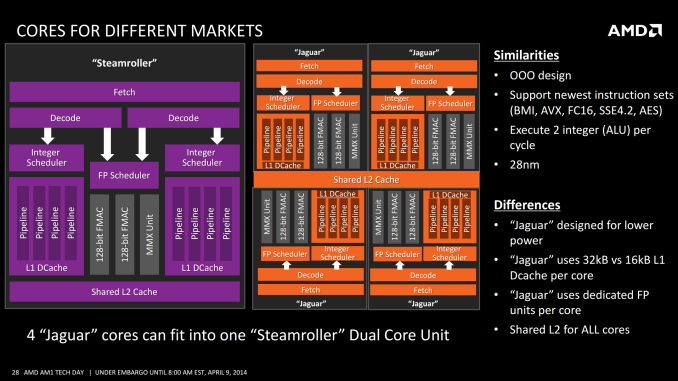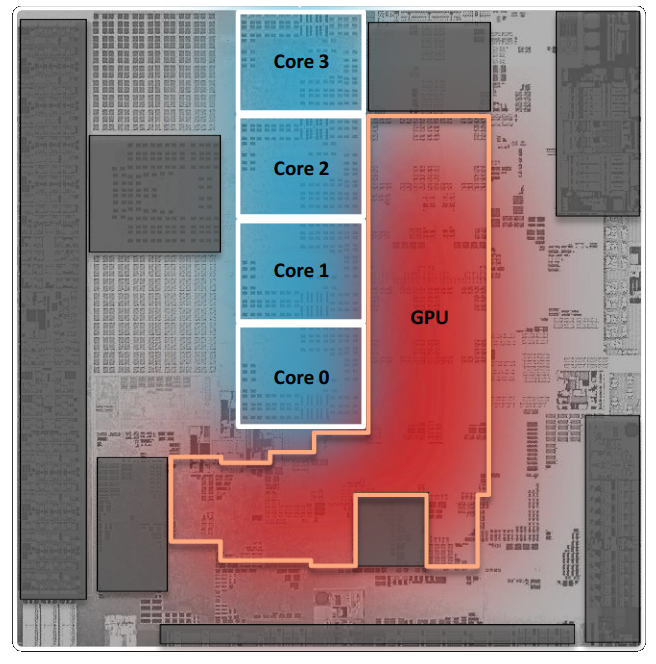AMD AM1 Kabini Part 2: Athlon 5350/5150 and Sempron 3850/2650 Tested
by Ian Cutress on May 29, 2014 2:00 PM EST
While there is a lot of focus on the mainstream desktop market, we hastily reviewed the new entrant to the low-end socketed desktop from AMD, the AM1 Kabini platform back in April. Since then we have acquired all four members of the family, the two quad core Athlon APUs and the two Sempron APUs, for testing. AMD’s movement into the upgradable tablet/desktop crossover arena is an interesting one for sure.
What Is The Point of AM1?
AMD’s reason for releasing a socketed low-power platform was derived from requests in low cost areas of the market. System integrators and companies in South America, Africa and Central Asia wanted a base system which would run an operating system which could be upgraded in the future to higher specification components, rather than sticking with a low-power but non-upgradable mobile CPU. The end result was AM1, the name given to a system using an FS1b socket with a desktop Kabini APU and an aim to build an upgradable CPU/motherboard combination for around $60.
Typically when dealing with the low cost/low power end of the spectrum, these systems are designed such that the APU is soldered on to the motherboard. When a user wants one model in particular, it comes as part of a package, much in the same way as a mobile device. In fact we even played a small game of ‘spot the desktop Kabini’ back at Computex 2013 and saw models such as the aptly named KBN-I from ECS, using the soldered A6-5200 APU:
These systems often find their way into applications that have long upgrade cycles, such as embedded and digital signage. The novelty of an upgradeable, socketed package makes most sense in the desktop arena. With low cost segments focusing more on the entry-level segmentation, AMD believe that having this upgradeability might drive pressure in the entry market towards these upgradeable PC-like devices.
AMD is marketing the series as a cheap, low powered way to go to quad core. When building a CPU architecture there is often a point in frequency scaling which is most efficient, and any deviation from that causes a less-than-linear gain in performance for power. Under this paradigm, and the importance of single core speed, the general feeling at AnandTech is that single core performance is preferred to more cores. If we can get the same multi-core performance using half the number of cores within the same power bracket, then this solution would be preferred. The final piece of that puzzle however comes in terms of design and price, both of which are points that AMD is also aiming to be competitive.
Desktop Kabini
There are a total of four AM1 APUs on the market:
| AMD AM1 Kabini APUs | ||||
| Athlon 5350 | Athlon 5150 | Sempron 3850 | Sempron 2650 | |
| CPU Cores | 4 | 4 | 4 | 2 |
| CPU Frequency | 2.05 GHz | 1.60 GHz | 1.30 GHz | 1.45 GHz |
| GPU Cores | 128 | 128 | 128 | 128 |
| GPU Frequency | 600 MHz | 600 MHz | 450 MHz | 400 MHz |
| Memory Frequency | 1600 MHz | 1600 MHz | 1600 MHz | 1333 MHz |
| L2 Cache | 2 MB | 2 MB | 2 MB | 1 MB |
| TDP | 25 W | 25 W | 25 W | 25 W |
| Official Launch Price | $59 | $49 | $39 | $31 |
Each of these APUs features up to four 28nm Jaguar cores and a 128 SP implementation of AMD's GCN GPU. We've gone over both the Jaguar and GCN architectures in previous articles, so we won't spend a lot of time recapping them here. Jaguar is the latest in AMD's line of "cat" cores, designed to go up against Intel's Atom. GCN on the other hand is a well-known GPU design from AMD as well, cut down here to fit in a much smaller die area (and thermal envelope).
The Jaguar cores in Kabini are listed as 3.1mm2, and AMD is quoting that four of these cores will fit into a single Steamroller module. Unfortunately the dimensions of a Steamroller module are not known - a 32nm SOI Bulldozer module clocked in at 30.9 mm2 for example, but no equivalent number is available for 28nm Steamroller. However some quick math shows four Jaguar cores populates 12.4 mm2. This leaves the rest of the core for the L2 cache, IGP and a large amount of IO.
In fact there are a few images that can help us predict total die size. In AMD’s slide deck, we have the following:
Given that one core is 3.1 mm2, extrapolating out gives the size of the die at 31.4x the size of a single core, or 97.3 mm2. The GPU area is approximately 5.2x the size of a core, giving ~16.1 mm2 for 128 GCN cores, compared to 12.4 mm2 for CPU cores. The Video Codec Engine and Unified Video Decoder are not part of these totals, located on other parts of the APU. The memory controller clocks in at ~9.4 mm2 and the display/IO portion runs at ~7.3 mm2.


















87 Comments
View All Comments
tarqsharq - Friday, May 30, 2014 - link
Or League of Legends.... I have a friend whose little brother would benefit from a machine that could run League without barfing.Low budget, bench some free to play games!
HighTech4US - Friday, May 30, 2014 - link
I have no need for any these underpowered CPUs from either Intel or AMD. As shown in the X264 tests the Intel Q8400 blows away all these low end parts. My main need is video encoding. Yes I know the Q8400 it is a 95 watt part but I recently spent $34 total to upgrade my 2008 system that has an Asus P5K Deluxe motherboard from a Q6600 105 watt CPU to a 50 watt Xeon L5420 50 watt CPU.$29 for the Intel L5420
http://cgi.ebay.com/ws/eBayISAPI.dll?ViewItem&...
Intel specs on the L5420
http://ark.intel.com/products/33929/Intel-Xeon-Pro...
$5 for the Socket LGA 771-775 adaptor
http://cgi.ebay.com/ws/eBayISAPI.dll?ViewItem&...
Intel specs on the Q6600
http://ark.intel.com/products/29765/Intel-Core2-Qu...
For $34 I have an upgraded system (100 mhz higher speed (2.5 vs 2.4 Ghz), 4MB (12 vs 8) more Cache, a higher FSB (1333 vs 1066) and much lower TPD (50 watts vs 105 watts) and this system put the hurt to all these low end parts.
I also sold off the Q6600 on eBay for $40 so my upgrade was basically FREE.
ozzuneoj86 - Saturday, May 31, 2014 - link
I've done this myself! While I wouldn't necessarily recommend that most people run out and buy an obsolete motherboard, mod it, buy expensive DDR2 and then buy a dirt cheap Xeon and mod that... BUT, I've modified a couple of systems like this and the performance per dollar is fantastic. I also like to use the L5240 3Ghz dual core 40W Xeons. Strictly from a performance per dollar perspective they will stomp all over any of these modern value CPUs, and you can pick up a pair of them for $15 or less. I own six or eight of them... I lost count... I also had a pair of L5420s, but used one to upgrade an old Dell which I sold for a $300 profit. I have two Dual Xeon boards I picked up on ebay a year and a half ago for $60 each, and have two L5240 3Ghz Duals in them. Performance in most cases should be similar to a desktop i3, but I only had to invest around $200 into the CPUs, coolers, motherboard and 8Gb of (unbuffered) ECC DDR2.These systems don't sip power by any means, so I wouldn't recommend them as file servers but they aren't bad for normal usage cases. One of my Dual Xeon systems is my living room gaming\htpc, coupled with a 350W Seasonic 80plus PSU I got on ebay for $15 and a Radeon HD 7750 I got on sale for $40... it's really quite a powerful system for how inexpensive it was.
casteve - Friday, May 30, 2014 - link
Thanks for the review, Ian.Perhaps this would have been better covered from a more likely scenario - web browser/office productivity, and HTPC. I can't imagine anyone using these for scientific/big gaming/video encoding set ups. Might be handy as a HTPC in the den - what's the HQV score, for example? How well does it perform with lower need Steam games. Heck, how well does it perform with Steam streaming?
toyotabedzrock - Friday, May 30, 2014 - link
No tests of the hardware encoding engines?haardrr - Saturday, May 31, 2014 - link
back-the-day i was rooting for AMD, and i was pissed at the fact the anandtech used intel processors that were 3-4 times more expensive than AMD...i kept hoping that AMD was equal or faster than Intel. Sadly NEVER!.
the closest that amd came was an oc'd FX8350 against a stock 4570k.
But AMD had to use double the power consumption!...
fast forward to right now, i bought the 5150 and a asrock am1h-itx. The asrock am1 motherboard is awesome (maybe a bit expensive, but it has dc-in, all all the standard outputs; no overclocking though)
Dissappointed by the 5150, and wondered if a 25% bump in clock speed that the 5350 has would fix the "slow" feel i get from the 5150, i bought the 5350 on sale at 65.
while AMD has priced the 5350, to "theoretically" match the performance of a g3420, (5350's can't match it in normal use)
a celeron g1610/ g1810 on 14.04 linux has better mythtv deinterlacing, than the 5350 does.
there was a time that you needed an Nvidia GPU (VDPAU) for proper deinterlacing, but with intels open source work, the NVIDIA card is now not necessary but an asset. Whereas with the 5350 requires an NVIDIA card (gt630v2 gk208)... maybe someday the AMD engineers will think that the Hardware features that they build into their processors, should be usable under linux...
i bought the 5350 thinking that it would work well with MythTV... thinking that it could handle openGL high quality, yadif 2x deinterlacing, or even greedymotion 2x... it can't!. the best you can hope for is Yadif. and to get that you need to install the oibaf PPA to get VDPAU!... mind you it does use alot less power than the openGL deinterlacing. the main problem is AMD just does not care about free opensource opengl drivers (the ps4 while "linux" is not open, thus not open source, so AMD cares about it) so Mythtv sucks on the amd 5350. the only advantage the the 5350/asrock am1h-itx has is that it idles at 16 watts(laptop 19v psu), and the msi h61i/g3420 idles at 19 watts.(tfx bronze 300w... surprisingly efficent at low level, equal or 2watts better than the gold seasonic tfx. at the 20 watt level)
THE PROBLEM IS THAT the intel g3420 on trusty tahr(14.04) can deinterlace OTA HDTV 1080i, at yadif 2x... for 30 dollars more. in order for the 5350 system to deinterlace properly, requires an nvidia gt640v2 at 70.
to sum up, I regret buying the 5150 (waste of silicon), the 5350 can be useful under some scenarios, and the asrock am1h-itx( while 75$, has dc-in) is absolutely required to make the 5350 useful.
AMD has got to stop Acting like a loser (cut back, way back because they are a console CPU maker, and perhaps a server cpu maker) and produce a cpu that is better than intels.
jospoortvliet - Sunday, June 1, 2014 - link
Well, good to know these AMD CPU's suck for a basic mythtv box... Too bad.Soul_Est - Sunday, July 27, 2014 - link
I was looking to do the same thing under Linux using the 5350. Arch Linux + ( MythTV || TVHeadEnd ) + XBMC. Well, I'll start my HTPC planning from square one again.The PS4 runs FreeBSD and not Linux IIRC.
Soul_Est - Sunday, July 27, 2014 - link
Wish I could edit my own replies.Just did the pricing on the AMD (Athlon 5350, ASUS AM1I-A) and the Intel (Celeron G1820, BIOSTAR Hi-Fi B85N) components and they are similar in price. Too similar given what may be a large performance delta. Would the G1820 handle yadif 2x much better you think?
Soul_Est - Sunday, July 27, 2014 - link
Given that I don't know what your complete setup is haardrr, what do you make of this? http://www.mythtv.org/wiki/Vdpau#AMD